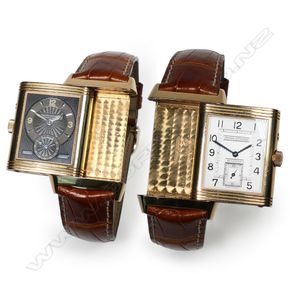18ct Rose Gold Jaeger-LeCoultre Reverso Duo Face Wristwatch
An 18ct rose gold Jaeger-LeCoultre 'Reverso' Duo Face Day-Night wristwatch, ref.270.2.54, c. 2000. with two individually adjustable time zone dials on a brown alligator strap with 18ct rose gold Jaeger-LeCoultre deployant clasp. Oblong 2.6 x 4 cm case with reeded bezel, push button on the case wall to adjust the second time zone, sapphire crystals. One face: Silver with guilloche dial, opaline chapter ring with Arabic numerals, conforming subsidiary seconds dial, both with blued steel baton hands. The second face: Anthracite-grey, radial guilloche dial with a Clous de Paris guilloche perimeter, luminous Arabic numerals 12, 3, 9 and silver baton indexes, luminous epee hands, subsidiary 24-hour dial. The case interior back with fausses cotes decoration, named and Swiss assay marked, the back named and with serial number.
You must be a subscriber, and be logged in to view price and dealer details.
Subscribe Now to view actual auction price for this item
When you subscribe, you have the option of setting the currency in which to display prices to $Au, $US, $NZ or Stg.
This item has been sold, and the description, image and price are for reference purposes only.
- Baton Numerals - A watch that instead of displaying numerals on the face, displays a marker in the form of a baton, or lower case letter "L". Since the baton-like marks are not numerals, the feature is also called baton markers, baton indexes and baton indicators.
- Assay / Assayed - Assaying is the testing of a metal, most commonly silver and gold to determine its ingredients and quality. In Britain, once an item of silver or gold has been assayed, a mark is stamped on it, certifying its purity. Known as hallmark, it derives its name from the Guild Hall of the Goldsmiths' Company, who recieved its Charter in 1327 giving it the power to assay and mark articles of gold and silver.
- Bezel - On a clock or watch, the bezel is the metal frame into which the watch or clock glass is fitted. In clocks, the bezel may include a hinge and a flange, in effect a door to the face of the clock. In jewellery the bezel is a band of metal with a projecting lip that holds the gemstone in its setting.
- Guilloche - A form of classical decoration consisting of a repeating ornament of interlacing curved bands, sometimes forming circles, and further decorated with rosettes or other flower forms.
The name is derived from the inventor, French engineer Guillot, who invented a mechanical method of inscribing fine repeating patterns on to metallic surfaces.
On enamelled items with guilloche decoration, the surface is firstly engraved with the repeating pattern, and then covered with several layers of enamel, each of which is fired.
Where the item has not been enamelled the form of decoration is usually called "engine turned". - Baton Hands - A narrow hand on a watch, sometimes also called a stick hand.
- Chapter Ring - A separate metal plate on the face of a clock, on which the numerals for the hours and sometimes parts of the hours, are displayed, usually wheel shaped and sitting on top of the dial plate. The chapter ring is often a feature of the clock and can be silvered or enamelled to stand as a contrast to its background. The hours are usually shown in Roman numerals, although in the late 19th and earlt 20th century, Arabic numerals became fashionable.
This item has been included into following indexes:
